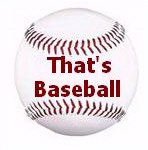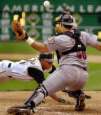 |
Baseball Terms
B
|
 |
Companion Sites: Nevada Dusters They Played the Game
|
||
A C D E F G H I J K L M N O P Q R S T U V W X Y Z
|
||
    |
||
bat speed
The velocity of the bat as the batter swings. The conventional wisdom is that a hitter's success is relative to the bat speed he generates, since greater bat speed equals greater velocity of the batted ball.
batter's box
One of the rectangular (6' x 4') areas located six inches on either side of home plate.
"batter up!"
Umpire's call to summon a batter into the batter's box so that play can start (or resume). The call is made at the beginning of the game, at the start of each half inning, and after a long time out.
battery
The team of pitcher and catcher. First used: 1868 (Chadwick Scrapbooks). The term was, apparently, borrowed from the military, more specifically the artillery, since the pitcher "fires" the ball and the catcher, it might be said, acts as the "spotter." But not everyone accepts this theory of the term's origin.
batting
Attempting to hit a pitched ball. First used: 1861 (Sunday Mercury, Aug. 10).
batting average
The statistical measure of a hitter's ability, determined by dividing the number of hits made by the number of official at-bats and expressed in thousandths (though sometimes you will see it carried beyond three decimal places). The standard of excellence is .300, and only eight batters have achieved a .400-or-better average since 1900, the most recent being Ted Williams, who hit .406 in 1941. First used: 1880 (Brooklyn Daily Eagle, Aug. 16.)
batting cage
A framework enclosed on three sides by wire, and usually portable, which is placed behind home plate during batting practice. Or, a totally enclosed (and usually permanent) rectangular area located near the field and used for the same purpose.
batting helmet
Protective headgear made of shatterproof plastic, which a batter wears while batting and while running the bases. Wearing a helmet has been mandatory in the major leagues since 1971. The 1941 Brooklyn Dodgers were the first to experiment with a batting helmet for the entire team, and the 1953 Pittsburgh Pirates were the first to adopt them permanently, but such protection dates back to at least 1905, when a "pneumatic headprotector" was patented by A.J. Reach Co.
batting order
The listing of the order in which batters will come to the plate as created by the manager and submitted to the home plate umpire prior to the start of a game. First used: 1901 (Frank Merriwell's Marvel, Burt L. Standish).
batting out of turn
Occurs when a batter comes to the plate out of his proper place in the batting order. He can be declared out by the umpire on appeal by the other team.
batting practice
Otherwise known as "BP," this occurs prior to a game so that hitters can work on their swings and adjust to wind, light, etc. First used: 1908 (Baseball Magazine, June).
batting stance
The stance taken by a batter in the batting box as he prepares for the pitched ball. Different batters have different stances, and sometimes the same batter will have different stances depending on whether he is attempting to hit the ball in a particular direction, or as determined by the situation at the time.
batting title
The honor accorded to the hitter in each of the major leagues who ends the regular season with the highest batting average. The batter must have 502 official plates appearances to be eligible. (That's 3.1 PA times 162 games.)
bat weight
Doughnut-shaped ring, either metal or plastic, that is placed on the barrel of a bat to make it heavier than usual, and used by the batter waiting in the on-deck circle to limber up or strengthen his arm and wrists prior to batting. In the "old days" batters swung two (or more) bats around for this purpose.
bazooka
A device that shoots fly balls and line drives for fielding practice.
beanball
A pitch thrown intentionally at the head of a batter, either to move him back off the plate or as retaliation for something the batter -- or his team, or a teammate -- has done. If an umpire determines that the offending pitch was intentionally thrown he can eject the pitcher from the game. On August 16, 1920, Ray Chapman of the Cleveland Indians was killed by a pitch thrown by Carl Mays of the New York Yankees. First used: 1905 (The Athletics of 1905, Charles Dryden).
beat a tag
What a baserunner has accomplished when he reaches base before a fielded ball is thrown to the baseman.
beef
A protest, loud and prolonged, on the field, usually aimed at an umpire by a player or a manager. First used: 1908 (New York Evening Journal, May 27).
Beer & Whiskey League
A nickname for the American Association, which existed from 1882 to 1891, because the AA tolerated alcohol in the ballparks. Also, a number of its most prominent backers and franchise owners had ties to the beverage industry.
behind
Said of a team that is losing; or of a pitcher, who is said to be "behind" in the count if he has thrown more balls than strikes to a batter; or of the batter if the pitcher has thrown more strikes than balls to him. Being "ahead in the count" would, of course, mean the opposite.
belt
To hit a ball hard. First used: 1891 (Chicago Herald, Aug. 25).
belt high
Said of a called strike located at the level of the batter's belt.
bench
The seating area of the a dugout. First used: 1891 (Chicago Inter-Ocean, May 5). Figuratively speaking, the place where those who are not participating in a game languish. To be "benched" is to be removed from a game (or a lineup) by the manager; First used: 1902 (Sporting Life, July 12).
bench clearing
When the dugout empties abruptly -- usually because a fight has broken out on the field and the rest of the team feels compelled to participate.
bench jockey
A player who, from the dugout, verbally abuses the players of the opposing team or the umpires. First used: 1939 (Baseball: The Fans' Game, Gordon S. "Mickey" Cochrane).
bench player
A player who usually is not in the starting lineup, but who may be called upon to play, perhaps as a pinch-hitter, or as a substitution in the field.
bench warmer
A substitute player who spends most of his time on the bench. First used: 1889 (Cincinnati Times, Feb. 8).
bent-leg slide
A technique for sliding in which the runner bends both legs as he nears the base. Sliding with straightened legs sometimes results in serious injury when the baserunner's spikes get caught in the dirt.
between the white lines
On the field of play. Figuratively, this term refers to the action of the game itself, as opposed to off-the-field activity.
B game
A game organized during spring training so that second-stringers and players called up from the minors can have more playing time and can be better evaluated.
Big Bertha
(1) The nickname given to the oversized catcher's mitt designed by Baltimore Orioles manager Paul Richards for use by Gus Triandos when catching for knuckleballer Hoyt Wilhelm. The mitt, made by Wilson, was 45 inches around. (2) The cleanup hitter. (3) A huge hit.
big cut
A mighty swing of the bat, as by a batter who is trying to hit one "out of the park".
big hit
A clutch hit, or a home run. First used: 1922 (Spalding's Official Base Ball Guide).
big hop
A batted ball that bounces high and is usually easy to play, as the fielder has time to judge its downward trajectory.
big inning
An inning in which a lot of runs are scored by a team (at least three). Some theorize that teams which regularly have big innings are more likely to be winners, and while this may seem logical there are others who disagree.
big league
A major league. First used: 1884 (Sporting Life, Oct. 15). It is generally believed that the term originated in reference to the National League of old, which had twelve teams in it, which, at the time, was a lot. Shortened to "the Bigs."
Big Red Machine
Nickname given the Cincinnati Reds in the mid- and late-1970s, a period during which they won back-to-back World Series (1975, 1976).
big stick
Synonym for a heavy hitter. First used: 1908 (New York Herald, May 5).
bite
To swing at a bad pitch. First used: 1905 (Sporting Life, Sept. 2).
Black Betsy
A very large black bat used by Shoeless Joe Jackson (and other sluggers) and a term said to have been originated by manufacturer A.G. Spalding & Co. Johnson's bat was 36 inches long and weighed 40 ounces.
Black Sox
A nickname given the 1919 Chicago White Sox team, which included eight players who were accused of conspiring with gamblers to lose the World Series. (Those players were Eddie Cicotte, Happy Felsch, Chick Gandil, Shoeless Joe Jackson, Fred McMullin, Swede Risberg, Buck Weaver and Lefty Williams.
blank
To allow no runs in an inning, or in a game. First used: 1862 (New York Sunday Mercury, June 29).
blast
(1) A hard-hit ball, usually a home run.
bleachers
Originally this term was used to identify the unreserved benches at a ballpark which were usually the most inexpensive, and the most far removed from the diamond, as opposed to the fieldbox or grandstand.
bleeder
A batted ball that, because of its slow progress or erratic progress , is not fielded in time to throw the baserunner out. First used: 1937 (San Francisco Examiner, March 11).
block
The defensive action performed by the catcher to prevent a baserunner from reaching home (or any fielder to prevent a baserunner from reaching a base). If it isn't done while in possession of the ball, it's illegal. First used: 1902 (Sporting Life, July 12). "Blocking the plate" refers to this action as performed by a catcher.
blocked ball
A ball in play which is stopped or handled or in some way interfered with by a person who is not participating in the game, or which touches an object which is not part of the game. This results in a dead ball situation (though that was not the case in 19th century baseball).
blooper
A ball poorly hit which drops between the behind the infielders but in front of the outfielders for a hit. Also known as a "Texas Leaguer." First used: 1937 (New York Times, Oct. 8).
blow
(1) To fail in some way, as in to lose a game (especially one that you were winning at some point); (2) What an umpire does when he makes a bad call; (3) A hard-hit ball.
blown save
A statistic charged to a relief pitcher who enters the game with the lead, and leaves having given up that lead. It was introduced in 1988.
blue
Synonym of umpire, derived from the color of the umpire's uniform.
Blue Book
The rules governing Major League Baseball, as distinguished from the official rules of the game itself.
bobble
To mishandle or drop a batted or thrown ball in such a way that an error results. Originally a "westernism," slang for "mistake."
bomb
(1) To get numerous hits or runs against a team (or pitcher), or to defeat the other team in decisive fashion. First used: 1905 (Sporting Life, Sept. 2). (2) A synonym for "home run."
bomber
A home run hitter. The Bronx Bombers were a collection of such hitters.
|
||
     <<<<< Baseball Terms: B, Page 1
|
||